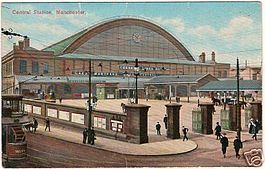Grid reference SJ837977 Opened 1 July 1880 Platforms in use 9 | Area City of Manchester 5 May 1969 Closed | |
 | ||
Post-grouping Cheshire Lines CommitteeLondon Midland Region of British Railways Similar Manchester Central Conventi, Stockport Tiviot Dale railway st, Manchester Exchange railway st, Mosley Street tram stop, High Street tram stop | ||
Manchester Central railway station is a former railway station in Manchester city centre, England. One of Manchester's main railway terminals between 1880 and 1969, it has been converted into an exhibition and conference centre named Manchester Central. The structure is a Grade II* listed building.
Contents
- Map of Manchester Central Manchester UK
- History
- Construction details
- Railway usage
- Accidents and incidents
- Dereliction and redevelopment
- Light rail
- References
Map of Manchester Central, Manchester, UK
History
The station was built between 1875 and 1880 by the Cheshire Lines Committee (CLC), and was officially opened on 1 July 1880. The architect was Sir John Fowler and the engineers were Richard Johnson, Andrew Johnston and Charles Sacré for the three companies which formed the CLC.
While it was being built, a temporary facility, Manchester Free Trade Hall Station (after the Free Trade Hall a landmark building nearby) was in use from 9 September 1877. It had two wooden platforms serving four tracks. When the station opened, the temporary station became Manchester Central Goods.
In 1963 building was Grade II* listed for its special architectural or historic interest.
Construction details
The station's roof is a single span wrought iron truss structure 550 feet (168 m) long with a span of 210 feet (64 m), and was 90 feet (27 m) high at its apex above the railtracks. Glass covered the middle section, timber (inside) and slate (outside) covered the outer quarters. The end screens were glazed with timber boarding surrounding the outer edges. It was constructed by Andrew Handyside and Co. The substructure and masonry partition were provided by Robert Neill and Sons of Manchester. Underneath the train shed is a large brick undercroft with intersecting tunnel vaults, above which were six platforms above street level which exited the station onto viaducts and bridges. The undercroft was used for storage and connected to the adjacent goods sidings by a carriage lift. The station's two-storey south wall has 15 bays separated by brick pilasters. At ground-floor level the bays have three round-headed windows and at first-floor level three square-headed. In the 20th century a glazed canopy was erected at the entrance at north end.
A temporary wooden building, erected at the front of the station to house ticket offices and waiting rooms was planned to be replaced by a grander edifice, for example a hotel and railway offices as at London St Pancras, but remained in use until the station closed. The Midland Hotel was built by the Midland Railway in 1898-1903 on an adjacent site.
Railway usage
The Midland Railway (MR), one of the CLC's partners, used Manchester Central as its terminus for services including express trains to London St Pancras. Beginning in 1938, the London, Midland and Scottish Railway (successor to the MR) ran two prestige expresses, The Peaks and the Palatine, stopping en route at Chinley, Millers Dale, Matlock, Derby and Leicester.
Between 1960 and 15 April 1966, during the electrification of the West Coast Main Line, Central Station was the terminus for the Midland Pullman, a streamlined blue six-coach diesel multiple unit. This stopped at Cheadle Heath (now closed), before running fast to St Pancras.
Services through Millers Dale finished in July 1968 when the line was closed as a through route. The station provided local services to Chester and Liverpool but closed to passengers on 5 May 1969, when the remaining services were switched to Manchester Oxford Road and Manchester Piccadilly stations.
Accidents and incidents
Dereliction and redevelopment
Over a decade Central Station fell into a dilapidated state, was damaged by fire, and was used as a car park. The property was acquired by Greater Manchester Council and in 1982, work began on converting it into an exhibition centre, which opened in 1986 as the Greater Manchester Exhibition and Conference Centre or G-Mex. It was subsequently renamed Manchester Central in honour of its railway history. The undercroft was converted into a car park, serving the centre and Bridgewater Hall.
Light rail
The opening in 1992 of the Metrolink light rail system has seen the conversion of suburban heavy rail lines such as the former Manchester, South Junction and Altrincham Railway to Altrincham, and the disused Cheshire Lines Committee route via Didsbury. With the introduction of Metrolink, rail services from south Manchester run once more to Central Station. However, instead of trains running into the Central Station arch, light rail vehicles now cross the railway viaduct and stop at Deansgate-Castlefield tram stop. They then run down a ramp which runs parallel to Lower Mosley Street, alongside the south-eastern side of the former train shed, before reaching street level where they operate as trams and head towards St Peter's Square.
